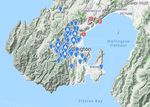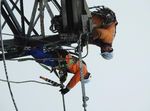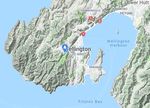CHIRPINGS - Forest and Bird
←
→
Page content transcription
If your browser does not render page correctly, please read the page content below
CHIRPINGS
The e-magazine of the Wellington Branch of Forest & Bird
Edition 9: Mar 2019
By Mike Britton, Chair, Wellington Branch
A victory for nature
As I am sure most of you have heard, the Minister of
Conservation has announced the addition of the 64,400 ha
Branch Mokihinui Valley to the Kahurangi National Park. This fabulous
news area has gone from being threatened, to being accorded the
highest level of protection — one that can only be revoked by
Parliament.
Forest & Bird was one of the key players in stopping Meridian from damming and flooding this
pristine and natural ecosystem. At the time it was a big
challenge, with a pro-development National government and a
Department of Conservation that was standing back from its
statutory role of advocating for nature and conservation land in
Resource Management Act hearings. But in this case the then
Director General of DoC, Al Morrison, came out fighting as did
the membership of Forest & Bird and our allies.
Things like success in stopping the dam is why lots of people
belong to Forest & Bird and give their voice to nature, to make a
difference. Many individual members wrote submissions and
attended meetings. And when asked, they put their hands in
their pockets to help fund the campaign and the potential legal
costs. When we have a win like this it is a time for every member Female rifleman
to feel proud and engage in a little back patting.
Have you been attending the Wild Wednesday talks organised by Marc Slade on behalf of the
branch? The most recent one was ‘A Plastic Ocean’ run in
conjunction with Forest & Bird Youth. Scary stuff, and I am sure
others like me completely re-evaluated how we are managing
our plastic consumption and use. There are sea birds dying from
stomachs stuffed with plastic objects like cigarette lighters.
Horror! See the next series of talks mentioned in this newsletter.
And more good news. Recently, titipounamu/rifleman were
returned to Wellington with 60 birds recently released in
Zealandia. The spark that gets the wider community to support
us stopping dams and addressing climate change, is
experiencing nature in places like Zealandia, and it is a big part
of making people care.
Male rifleman
As David Attenborough famously said, “No one will protect what
they don’t care about, and no one will care about what they haven’t experienced.”
1Local news
Plants had a great start early in the year with a wet spring, and when summer turned up the heat,
many species produced fruits and seeds in abundance. This was good for birds and plant
propagation but also for pests so we may see a rise in rodents
trapped under the Predator Free Wellington project.
Late in the summer a long period without rain dried up many
shallow wetlands. Some of the pools and ponds at Pauatahanui
wildlife reserve were cracked dry mud by mid-February. The
pools by Thorpe hide were low, and hopefully the banded rails
that recently appeared there have stuck it out through the
harsher conditions. Spotless
crake have also been sighted
at the reserve and a number Taupata with masses of berries
of unbanded fern birds have been reported indicating successful
breeding from the birds translocated there from Taranaki.
Half a dozen black fronted terns called at Wellington in March.
Black fronted terns breed on South Island river beds and in
autumn they head north. Wellington must be a convenient stop
Dry pool bed at Pauatahanui after crossing
the strait before they carry on to their wintering
grounds.
They are smaller than the much more common
white fronted tern, greyer and show a white rump
in flight. They too have a forked tail, but it does not
have the streamers of the white front and is much
shorter. The adults are easy to distinguish from
their bigger cousins by their orange beaks, legs and
feet. Adult black fronted tern in non-breeding plumage
Health and Safety — is it all a big waste of our time?
The background
There’s a lot of emphasis on Health and Safety (H&S) these days. It seems that as a
nation we have become so risk averse that we will no longer let children play in a
tree house — or let Forest & Bird members start a working bee without a long
lecture about the risks they could encounter. Understandably, this can be
irritating to members who have worked safely in the bush for many years without
what they perceive as “nanny state” hectoring about every trip hazard — or the
need to wear sunscreen or a hi vis vest.
While this increasing nervousness about risk has been around generally for quite a few years, the
major concern for Forest & Bird these days is the Health and Safety at Work Act 2015 (the Act)1.
Under this Act, any organisation that has even a single employee is classified as a “person
conducting a business or undertaking” (PCBU), whether that business is for profit or not.
Forest & Bird, with over 50 staff in its National Office, is a PCBU. The Act makes clear that, with
respect to H&S issues, Forest & Bird’s volunteers are treated in the same way as its employees.
1 www.legislation.govt.nz/act/public/2015/0070/55.0/DLM5976660.html
2The Act also specifically prohibits anyone from insuring against their liabilities under the Act, and
furthermore there are some eye-watering penalties for behaviour that breaches the Act’s
provisions, even more so if that behaviour could be deemed “reckless”.
The changes
Consequently, to protect itself, its staff and volunteers, Forest & Bird has introduced some new H&S
processes. Each branch has nominated a H&S representative; one
of that person’s aims will be to ensure that their branch, and
therefore Forest & Bird as a whole, is compliant with the Act.
A major concern is that, if a H&S “incident” occurs, we may not be
able to prove that we took all “reasonably practicable” steps to
prevent the incident occurring. As far as the Act is concerned, if it
isn’t recorded, it didn’t happen. Appropriate records may be
electronic or on paper, but they must exist — it may be no defence
simply to say “… but I warned them of the risks”.
This makes for a tricky balance between what’s practical and
what’s required by the Act. The National H&S Officer, working with
the branch H&S reps, has developed, and will continue to develop,
H&S procedures that (ideally) will have as little impact on
volunteers as possible, while still ensuring that Forest & Bird is
compliant with the Act.
H&S is planned to suit the hazard
So there are (or will be) H&S management plans for every branch
project, site risk assessments, and various forms and templates — but almost all of this will be
unseen by most volunteers.
What volunteers will see, at the start of every working bee for example, is a form
asking you to record details for an emergency contact person — and you may also
be asked to initial a form that states that you have received a H&S briefing.
The information collected will only be used for compliance with the Act —
it will not be used for any other purpose.
These processes are already largely in place on Wellington Branch projects — and
volunteers are becoming used to this minor amount of bureaucracy.
To summarise
H&S is important — but we need to keep it in perspective. Our H&S record is very good. We already
do it mostly by the book but must be sure we can prove it — in the unlikely event of an incident.
Whatever our feelings about H&S and the Act, it has legal force. We are all individually responsible
for staying safe and for ensuring that Forest & Bird doesn’t breach the provisions of the Act.
eBird with thanks to Geoff de Lisle of Birds NZ
eBird is an online birding tool that can be used for many purposes. Essentially it is a database that
anyone can use to look up or record locations of birds seen anywhere in the world. Full-on birding
enthusiasts record every species and the number of individual birds of each type that they saw on
each birdwatching trip, or even on the walk to work. Others record the species seen but not the
number, and some people do check-sheets for particular trips, or if they see a rare species or an
interesting bird in an unusual place.
This enables others to see trends over time (it has historic records entered retrospectively from old
notebooks going back decades) and birding hotspots. Those keen to see particular species can look
up recent sightings in their area, which can be a great time saver.
3Data entry is easy and can be made using a mobile phone app or by computer. You can enter a GPS
reference, an address, a place name such as a reserve, or find the location on a map and describe it.
eBird prompts you with checklists of birds normally seen in the region you visited, and it can also
offer additional lists of rarities. You can insert photos including large files for high quality.
It is a fantastic resource for sharing records of birds encountered and for people keen to locate
species they’ve never seen before. Anyone can look at other people’s sightings, and if you register
you can enter your own records as well. Some inaccurate identifications have been corrected by
others more familiar with the area or species, which increases the value of the resource. This link
leads to the New Zealand home page.
When searching for information you can filter by location, species and time period and see what
species have been observed, where, when and by whom. By clicking on individual pins on the map
you can see who made the report, the exact location and any other information or photos the
submitter provided. If going to unfamiliar areas it is a great tool to find good places to see birds or
to locate special hotspots to see particular species. It is also a photo resource and you can look at
other people’s photos and also audio tracks with birdsong and calls recorded by people submitting
records.
These maps from eBird show kākā sightings in 2004 and 2017, showing the growth of the
population in Zealandia and their spread beyond the sanctuary. Kākā were transferred to Zealandia
between 2002 and 2007.
Kākā sightings in 2004 Kākā sightings in 2017
All up, eBird is a brilliant resource and the more people who use it the more useful it will become.
The Birds NZ website includes the following information about eBird:
A real-time, online checklist program, eBird has revolutionised the way that the birding community
reports and accesses information about birds. Launched in 2002 by the Cornell Lab of Ornithology
and National Audubon Society, eBird provides rich data sources for basic information on bird
abundance and distribution.
eBird’s goal is to maximize the utility and accessibility of the vast numbers of bird observations
made each year by recreational and professional bird watchers. It is amassing one of the largest and
fastest growing biodiversity data resources in existence.
There are over 111,000 checklists of New Zealand birds including records of 348 species.
4EVENTS
FOREST & BIRD WELLINGTON’S WILD WEDNESDAYS
Wednesday 10 April 2019
Kevin Hague — Restoring Nature
Forest & Bird CEO, Kevin Hague, will talk about Forest & Bird’s new campaign — Restoring Nature.
He will describe what needs to happen for conservation to succeed — including moving from only
protecting existing habitats to restoration at a landscape scale. How can we turn the tide from
slowly losing our native taonga to creating a sustainable future where people and nature flourish?
Venue: Forest & Bird National Office, 205 Victoria Street, Wellington
Please register your interest via Eventbrite
Price: Free/Koha
When: Doors open 5.45pm, talk starts 6.00pm –8.00
Wednesday 8 May 2019
Farming for the Future — Dr Mike Joy & Alison Dewes
Dr Mike Joy, Senior Researcher at the Institute for Governance and Policy Studies, Victoria
University Wellington and Alison Dewes, Head of Environment at Pamu/Landcorp Farming Ltd will
discuss the future of farming, looking at how we need to change our current food system to adapt to
and mitigate climate change, restore freshwater and biodiversity and remain competitive in a
changing global food market. This will be followed by a chaired discussion exploring the issues
raised.
Venue: RHLT1 Rutherford House, Victoria University of Wellington.
Tickets will be available via Eventbrite shortly.
Price: Koha
When: Doors open 5.45pm, talk starts 6.00pm – 8.00
Wednesday 12 June 2019
Conservation in cities: why it is hard and why we do it — Danielle Shanahan
Conservation in cities is hard. The impacts of urbanisation on native ecosystems are extremely high
and hard to overcome, and the remaining patches of habitat are often highly disturbed, weedy and
small. So why do we do conservation in these landscapes? What does it mean for biodiversity, and
for people? Are there special opportunities that we have in cities?
Join Danielle Shanahan, Director of Zealandia’s Centre for People and Nature, as she explores these
questions, drawing on examples from across the Oceania region.
Participants will have the opportunity to add their views during a facilitated discussion on what
biodiversity means for Wellingtonians.
This free seminar is brought to you by Zealandia and Forest & Bird Wellington.
Venue: Visitors’ Centre, Zealandia
Please register your interest via Eventbrite. (Limited spaces)
Price: Free/Koha
When: Doors open 5.45pm, talk starts 6.00pm – 8.00
5Wellybird – a personal view
The Tākapu or Australasian gannet is relatively common around Wellington, but mainly outside its
breeding season in the height of summer. Attempts to
encourage gannets to nest on Mana island using concrete
models resulted
for several years
in a sole male
falling for one of
the decoys, with
limited success
in the breeding department.
More recently there have been encouraging signs with
other birds showing interest in nesting. Otherwise the
next nearest colonies are at Cape Kidnappers and
Farewell Spit, and when feeding their chicks, the
At Cape Kidnappers
parents seldom venture as far as Wellington.
Out of the breeding season however they can be seen over the sea, harbour and Hutt River estuary.
Larger than gulls, and with adults whiter when seen at
distance, they are sometimes initially mistaken for the
smaller albatross species. But on closer inspection their
wings are a different shape, have black tips and trailing
edges and the head and beak is quite different from the
tubenose clan, of which
albatrosses are members.
They soar over water on the
lookout for prey and dive
spectacularly from height,
folding back their wings just before plunging into the water. They share
this habit with gannets in other parts of the world, and the closely
related boobies that generally
inhabit warmer waters, but which
pay occasional visits to New Zealand.
Around Wellington they are often in
pairs, and tend to patrol a patch of
sea for quite a while, often close to
the shoreline. The two photos of
gannets in flight were taken at Island
Green toe stripes - fancy footwork Bay in July.
At close quarters
E-newsletter
Do you have any ideas for subject matter or things you’d be interested in hearing about in this
newsletter? Please let us know by email to wellington.branch@forestandbird.org.nz. Any photos
submitted must include photographer’s credit and permission to be used.
Photos by the editor unless otherwise credited
6You can also read



























































